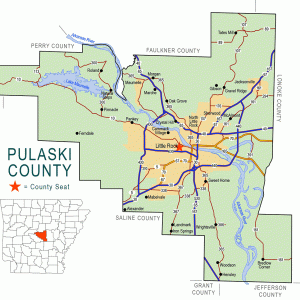calsfoundation@cals.org
Mabelvale (Pulaski County)
Mabelvale is a neighborhood in the southern part of Little Rock (Pulaski County). Beginning as a nineteenth-century railroad town, the community gradually grew along with Little Rock. It was annexed in the 1970s after considering incorporation as an independent city in the 1960s.
Mabelvale is located in the transportation corridor that today includes the Union Pacific Railroad and Interstate 30. Shortly after the establishment of Little Rock as the territorial capital, farmers and investors began purchasing land in the Mabelvale area. Purchasers included Allen Martin, Thomas Blair, and future governor James Sevier Conway. The military road known as the Southwest Trail improved transportation through the area in the 1830s. Surveyors for the Cairo and Fulton Railroad assessed the trail in the 1850s, but railroad construction did not begin in the area until the 1870s. Rail service between St. Louis, Missouri, and Texarkana (Miller County) by way of Little Rock began in 1873. Around this time, a railroad depot was built ten miles from downtown Little Rock, and a post office was established at Mabelvale in 1873.
The community is said to be named for the daughter of one of Mabelvale’s founders as a compromise; it is claimed that the founder wanted to name the community for himself but another founder wanted to call it Pinevale. The area was rich in pine trees at the time, which made it convenient for refueling the engines of the St. Louis, Iron Mountain and Southern Railroad. “Fuller’s earth” (bentonite) was discovered in the region, and lime kilns were built to process the mineral. A baking powder factory operated in Mabelvale during the latter part of the nineteenth century.
A lot was purchased in 1881 for the construction of a school in Mabelvale. In a letter to the Arkansas Gazette in 1885, a citizen boasted of the “sulphur-chalybeate” well water of Mabelvale, which was said to be preferred by trainmen passing through the area. By 1887, Mabelvale had three business houses, a blacksmith shop, a steam mill, a grist mill, a church, a Masonic lodge, the school, and several residences.
The railroad through Mabelvale was acquired by the Missouri Pacific Railroad in 1917, and rail service continued through the community. The establishment of the Pulaski County Special School District in 1927 consolidated thirty-eight school districts, including that of Mabelvale. Several white elementary and middle schools became feeder schools for Mabelvale High School, but no black students were accepted. During the Depression, Mabelvale had an active Home Demonstration Club that met in two buildings purchased from the Missouri Pacific Railroad. On March 14, 1952, the Mabelvale High School was destroyed by fire. More than 600 students met for classes in various buildings in Mabelvale, including the Methodist and Baptist churches, the American Legion hut, and the high school’s home economics and agriculture buildings. A new high school was completed by the end of 1953. In the first half of the 1960s, Interstate 30 was built connecting Little Rock with Dallas, Texas; the highway runs parallel to the railroad and cuts through the northwestern corner of Mabelvale. Construction of McClellan High School in 1966 brought about the conversion of Mabelvale’s high school to a junior high school. By this time, the school district had been desegregated.
In 1966, Little Rock voters were asked to approve an annexation that would add twenty-six square miles to the city, including the neighborhood of Mabelvale. The proposal was defeated. The next year, citizens of Mabelvale considered incorporating as a second-class city, largely to avoid annexation by Little Rock. The proposed city would have included about four square miles in southern Pulaski County, but it also failed to win approval. In May 1973, the city of Little Rock succeeded in annexing a large part of Pulaski County, including Mabelvale.
The Vendanta Society of Arkansas, a Hindu organization, has a cultural center in Mabelvale. The community also has a United Methodist church, a Missionary Baptist church, a Church of Christ, a nondenominational Christian church, and a Kingdom Hall of the Jehovah’s Witnesses. Mabelvale also has several stores and a barbecue restaurant.
Although the portion of Little Rock called Mabelvale is entirely within Pulaski County, the name historically has also been used to designate an unincorporated section of northern Saline County. The area was originally settled by German immigrants in the latter part of the nineteenth century and still bears the names of some of those families in its street names, including Kling Road and Heinke Road. In addition to homes, the area also has several businesses, particularly along Chicot Road.
For additional information:
Jones, Jimmy. “Mabelvale Fight to Avoid Annexation May Cost It More Than It Can Afford.” Arkansas Gazette, May 14, 1967, p. 6A.
Mabelvale High School Class of ’51. A History of Mabelvale School. N.p.: 1991.
Smart, Mary. “Mabelvale Said to be Only Postoffice of That Name.” Arkansas Democrat Magazine, July 19, 1951, p. 16.
Steven Teske
Butler Center for Arkansas Studies
 Pulaski County Map
Pulaski County Map 




Comments
No comments on this entry yet.